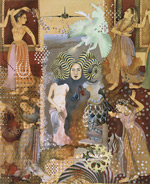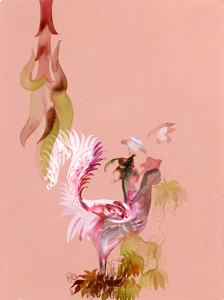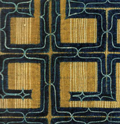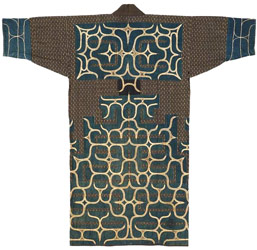Asian Arts Council 2022-2023 General Meeting Lectures
Each month the Asian Arts Council presents a program featuring a distinguished scholar, curator, collector or Asian arts enthusiast of note. We meet the last Thursday of the month in the Museum’s Boardroom at 1:00 p.m. and begin with a brief business meeting before the lecture. Meetings are FREE FOR EVERYONE on Zoom. Donations are welcome to help bring speakers to our members. (In person lecture meetings are free for AAC members, only $10 for Museum members, $12 for non-members and $8 for students).
Click on a date line below for a lecture summary from the Asian Arts Council Newsletter
Jul. 28 - 1:00 p.m. The Making of Shahzia Sikander: Extraordinary Realities Jan Howard, Houghton P. Metcalf Jr. Curator of Prints, Drawings and Photographs at the RISD (Rhode Island School of Design) Museum
The stunningly diverse subject matter and multiple mediums employed by the Pakistani/American  artist, Shahzia Sikander was highlighted by Jan Howard, curator of The Making of Shahzia Sikander: Extraordinary Realities. Having mastered miniature painting techniques at the National College of Arts, Lahore, Pakistan, Sikander created paintings juxtaposing traditional themes with contemporary viewpoints to encourage reassessment of stereotypes. Her exploration of layering multiple works on tracing paper presents the viewer with manifold meanings and shifts of perception to consider. Her
Pleasure Pillars, Shahzia Sikander, 2001
feminine perspective often emphasizes female agency, inner strength and creativity, challenging viewpoints of patriarchy and dominance. The breathtaking array of diverse mediums she works in – painting, drawing, printing, video animation, sculpture, and mosaics, from miniatures to large scale installations - signifies an endless supply of creative ideas.
artist, Shahzia Sikander was highlighted by Jan Howard, curator of The Making of Shahzia Sikander: Extraordinary Realities. Having mastered miniature painting techniques at the National College of Arts, Lahore, Pakistan, Sikander created paintings juxtaposing traditional themes with contemporary viewpoints to encourage reassessment of stereotypes. Her exploration of layering multiple works on tracing paper presents the viewer with manifold meanings and shifts of perception to consider. Her
Pleasure Pillars, Shahzia Sikander, 2001
feminine perspective often emphasizes female agency, inner strength and creativity, challenging viewpoints of patriarchy and dominance. The breathtaking array of diverse mediums she works in – painting, drawing, printing, video animation, sculpture, and mosaics, from miniatures to large scale installations - signifies an endless supply of creative ideas.

Jan Howard is Curator of Prints, Drawings and Photographs at the Rhode Island School of Design Museum. Prior to her arrival at RISD, she spent 14 years at The Baltimore Museum of Art as a curator in the Department of Prints, Drawings and Photographs. She trained at the Philadelphia Museum of Art and the Spencer Museum of Art at the University of Kansas, where she did her graduate work in art history. Her exhibitions and publications have focused on modern and contemporary art, including Shahzia Sikander: Extraordinary Realities, 2021.
(The SDMA’s evocative series of 10 Shahzia Sikander paintings based on works in the Edwin Binney 3rd Collection can be viewed on the Museum website.)
Figures: Pleasure Pillars, Shahzia Sikander, 2001.
To Desire, Shahzia Sikander, gouache painting, SDMA 2004.201. AAC enabled purchase.
Aug. 25 - 1:00 p.m. Ainu People and Their Textiles Mary Witztum, docent, San Diego Museum of Art, AAC Study Group
Mary Witztum presented her research into the world of the Ainu with Ainu People and Their Textiles, and offers this summary of her talk:  The Ainu are the indigenous peoples of Japan who have been found to be descendants of the Jomon people who first inhabited the Japanese islands. They also live and lived in the Russian Sakalin, Kamchatcka islands as well as the Kuril Islands. The Ainu culture is older than that of the ancient Egyptians or Sumerians; they are one of the oldest continuing cultures on earth. One of Chair Cover with Crane Designthe articles I found was entitled, Ainu Textiles: Cloth Weighted with Affection and Prayer, (Ann-Elise Lewallan & Kaizawa Tamami, The Garland Magazine) --this title so very aptly gives the gist of my talk.
The Ainu are the indigenous peoples of Japan who have been found to be descendants of the Jomon people who first inhabited the Japanese islands. They also live and lived in the Russian Sakalin, Kamchatcka islands as well as the Kuril Islands. The Ainu culture is older than that of the ancient Egyptians or Sumerians; they are one of the oldest continuing cultures on earth. One of Chair Cover with Crane Designthe articles I found was entitled, Ainu Textiles: Cloth Weighted with Affection and Prayer, (Ann-Elise Lewallan & Kaizawa Tamami, The Garland Magazine) --this title so very aptly gives the gist of my talk.  The fabric for which they are most known is made of fibers prepared from the bark of elm trees. Later, they also added trade cotton to their robes. I shared six categories of robes, designated by type of fabric and style. The abstract designs reflect the fact that they were creating a pattern that would ward off malevolent spirits. A wife took great pride in creating a robe for her husband to protect him. The patterns were created by an overlay of appliqué and then impeccable embroidery, resulting in mesmerizing designs, “drawing us into their labyrinths in a manner that makes it very hard to look away.” (Thomas Murray, Textiles of Japan, p. 20). But to understand and appreciate the textiles of the Ainu, one must understand the people and context in which textiles are produced. “The cloth knits individual Ainu to one another through prayer as a vessel of the artist’s affection. This prayer animates the cloth and conveys a spiritual force for the wearer or owner, maintaining good relations with the spiritual beings around us.” (Ann-Elise Lewallan & Kaizawa Tamami)
The fabric for which they are most known is made of fibers prepared from the bark of elm trees. Later, they also added trade cotton to their robes. I shared six categories of robes, designated by type of fabric and style. The abstract designs reflect the fact that they were creating a pattern that would ward off malevolent spirits. A wife took great pride in creating a robe for her husband to protect him. The patterns were created by an overlay of appliqué and then impeccable embroidery, resulting in mesmerizing designs, “drawing us into their labyrinths in a manner that makes it very hard to look away.” (Thomas Murray, Textiles of Japan, p. 20). But to understand and appreciate the textiles of the Ainu, one must understand the people and context in which textiles are produced. “The cloth knits individual Ainu to one another through prayer as a vessel of the artist’s affection. This prayer animates the cloth and conveys a spiritual force for the wearer or owner, maintaining good relations with the spiritual beings around us.” (Ann-Elise Lewallan & Kaizawa Tamami)
The goal in my talk was not only to share the textile art of the Ainu, but also to share their spiritual culture, which is interwoven into their art.these
Sep. 24 - 1:00 p.m. Collecting Chinese Porcelains at the Mughal Court Marika Sardar, Ph.D., independent scholar based in Toronto. Previously, Curator at the Aga Khan Museum, the Museum of Islamic Art in Doha, Qatar, the San Diego Museum of Art, and the Metropolitan Museum of Art
Oct. 27 - 1:00 p.m.
Bingata Textiles of Okinawa and the Ryûkyû Culture: History, Techniques and Application
Almiede (Allie) Arnell, AAC Study Group, docent, San Diego Museum of Art
Jan 26 - 1:00 p.m.
Spectacular Cycles of Life: The Bamboo Sculptures of Tanabe Chikuunsai IV Meher McArthur, Asian art curator, Japanese art historian
Feb 23 - 1:00 p.m.
Beyond Bollywood: Dance in the Arts of South Asia, Southeast Asia, and the Himalayan Region
Forrest McGill, Wattis Senior Curator of South and Southeast Asian Art, at the Asian Art Museum for more than twenty years. Previously, a museum administrator and a teacher, curator, researcher, and writer in Asian art
Mar 30 - 1:00 p.m.
The Art and Life of Fukuda Kodōjin: Japan’s Forgotten Poet and Landscape Artist
Andreas Marks, Ph.D., the Mary Griggs Burke Curator of Japanese and Korean Art at the Minneapolis Institute of Arts
Description
Apr 27 - 1:00 p.m.
Nothing = Something: Japanese Aesthetics in the Art of Sam Francis
Hollis Goodall, Curator of Japanese Art at LACMA
description
May 25 - 1:00 p.m.
Legacy of Ceylon: Art & Photography
Janet Baker, Ph.D, Curator of Asian Art, Phoenix Art Museum
description
Jun 29 - 1:00 p.m.
Miao and Hmong Textiles: Emblems of Tradition, Adaptation and Resilience
Elaine Pierce, MD, previously, Docent San Diego Museum of Art, AAC Study Group, retired from a career in medicine and public health, now teaching English as a Second Language
A summary of this lecture will be posted here the month after the lecture is given.

